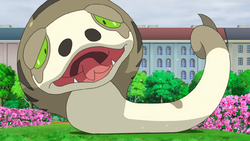Silicobra is a Pokémon which resembles a small snake. Its body is mostly brownish white with a few darker spots, and its tail is curled at the tip. It has oval green eyes with black pupils, each one surrounded by a brown spot similar to a sand stain and a brown protuberant ridge above it. Paired with its crooked downward mouth, its face is similar to a frown. It also has two big nostrils.
Silicobra has a dark yellow pouch around its neck, which it uses to store more than 17 pounds (8 kg) of sand. The pouch gets more elastic with every time Silicobra sheds its skin. Silicobra collects sand by swallowing it and shoots the sand from its nostrils, an ability it uses to blind predators so it can escape by burrowing into the ground. It also burrows into the sand in order to ambush its prey. Because Silicobra's nostrils are specialized for shooting out sand, it has a poor sense of smell.
Silicobra and its evolution, Sandaconda, are the only known Pokémon that can have Sand Spit as an Ability.
Evolution
Silicobra evolves into Sandaconda.
(For specifics on this Pokémon's Evolution in the games, refer to Game data→Evolution data.)
- Silicobra's Japanese name and category are identical, with the only difference being in how they are written: Silicobra's Japanese name is written in katakana (スナヘビ), while its category name is written in hiragana (すなへび). Silicobra is the only Pokémon with this distinction.
Origin
Silicobra resembles various snakes, and the sand pouch around its neck is similar to the hood of a cobra. It may be specifically based on the false cobra, a species that lives in deserts of North Africa and the Middle East, named so because much like a cobra, it can flare its neck into a hood when threatened.
With its ability to shoot sand from its nostrils as a defense mechanism, Silicobra may be inspired by spitting cobras, which spit venom out of their fangs in much the same way.
Name origin
Silicobra may be a combination of silicon (basic constituent of sand) and cobra. It may also incorporate silt.
Sunahebi may be a combination of 砂 suna (sand) and 蛇 hebi (snake).

 For other sprites and images, please see Silicobra images on the Bulbagarden Archives.
For other sprites and images, please see Silicobra images on the Bulbagarden Archives.








